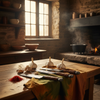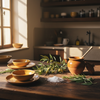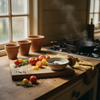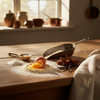Dutch Oven Soup Recipes: Cook Boldly, Serve Safely
Key Takeaways
- Dutch ovens provide superior heat retention and even cooking for high-quality soups.
- Recipes range from quick options like chicken noodle soup to longer-cooked hearty beef stew.
- Cooking involves searing, sautéing, and slow simmering all in one pot.
- Proper browning and layering flavors are essential steps for delicious results.
- Using chemical-free tools like DI ORO spatulas ensures safe stirring at high temperatures.
Table of Contents
- Why the Dutch Oven Reigns Supreme for Soup
- Types of Dutch Oven Soup Recipes (The Full Flavor Spectrum)
- Essential Ingredients for Dutch Oven Soups (Flavor Begins Here)
- Cooking Techniques & Tips for Dutch Oven Soup Mastery
- Serving Suggestions and Memorable Pairings
- Dutch Oven Soup Troubleshooting & Smart Solutions
Dutch Oven Soup Recipes: Cook Boldly, Serve Safely
Why the Dutch Oven Reigns Supreme for Soup
Cast iron's thermal mass stores and distributes heat with scientific precision. Unlike thin-walled pots that create hot spots, Dutch ovens maintain steady temperatures that prevent scorching while developing complex flavors through the Maillard reaction, that golden browning that makes beef stew taste like it simmered all day in a French bistro.
For home cooks seeking the best tools for dutch oven soup recipes, using a 3-piece seamless spatula set ensures you can scrape, stir, and serve without damaging your enamel or introducing unwanted chemicals.
The enamel coating creates a non-reactive surface that won't leach metals into acidic tomato-based soups. Heat retention stays consistent for 30% longer than stainless steel, meaning your simmering stays gentle even when the burner fluctuates. This translates to tender vegetables that hold their shape and proteins that break down into silky, fall-apart perfection.
Flavor development accelerates through superior fond creation, those caramelized bits that become the foundation of rich, restaurant-quality broths. When you deglaze with wine or stock, every brown bit dissolves into liquid gold.
For those who love to serve soups with ease, a seamless soup ladle is the perfect companion for transferring hearty stews and broths from pot to bowl without spills.
Science-Backed Benefits
To learn more about the science and tradition behind these classic pots, explore this comprehensive overview of Dutch ovens.
The DI ORO Difference in Dutch Oven Cooking
High-heat searing demands tools that won't melt, warp, or contaminate your food. DI ORO's award-winning seamless spatulas resist temperatures up to 600°F, perfect for browning beef chunks or scraping fond without scratching your enamel surface. Pro-grade, forever-chemical-free silicone means zero PFAS, zero BPA, and zero worry about what's touching your food.
The seamless design eliminates bacteria-harboring crevices while the flexible edge conforms to curved Dutch oven walls, ensuring every bit of flavor makes it into your bowl, not stuck to the pot.
Types of Dutch Oven Soup Recipes (The Full Flavor Spectrum)

From 30-minute weeknight winners to all-day weekend projects, dutch oven soup recipes span every craving and occasion. The beauty lies in versatility, one pot handles everything from delicate egg-drop textures to robust, stick-to-your-ribs stews.
If you're interested in more tips and inspiration, check out this helpful guide on dutch oven cooking for additional techniques and recipe ideas.
Chicken Soups (Comfort + Creativity)
Classic chicken noodle starts with browning bone-in thighs for 8 minutes, building a golden foundation before adding aromatics. Greek avgolemono elevates the concept with orzo and a silky egg-lemon finish that requires gentle stirring, perfect for DI ORO's heat-resistant precision. Chicken fajita soup brings Tex-Mex flair with bell peppers, cumin, and a splash of lime that brightens the entire pot.
Beef & Hearty Stews
Dutch oven beef stew transforms tough chuck roast through low, slow braising. Sear 2-inch cubes in batches, deglaze with red wine, then transfer to a 325°F oven for 2.5 hours. Italian wedding soup combines handmade meatballs with escarole and tiny pasta, while lasagna soup delivers all the comfort of the classic in 45 minutes with broken lasagna sheets and three-cheese richness.
Sausage Standouts
Italian sausage tortellini soup leverages pre-cooked sausage for 20-minute active time, brown the links, add broth and canned tomatoes, then fresh tortellini in the final 8 minutes. Pumpkin sausage soup balances savory breakfast sausage with sweet winter squash and a touch of cream for velvety texture.
Seafood Soups
Cioppino showcases mixed shellfish in a wine-spiked tomato broth that simmers for exactly 12 minutes, any longer and the seafood turns rubbery. Layer mussels, clams, and firm fish with precise timing for restaurant-worthy results. Spicy shrimp pho builds complex broth through charred onions and aromatic spices before adding rice noodles and quick-cooking shrimp.
Vegetarian & Vegan Varieties
Creamy root vegetable soup purees roasted carrots, parsnips, and potatoes with vegetable stock and coconut milk for a silky texture. Italian minestrone showcases seasonal vegetables, white beans, and pasta in a tomato-herb broth that improves with time, perfect for meal prep enthusiasts.
These plant-based dutch oven soup recipes prove that vegetables can deliver the same soul-warming satisfaction as their meat-based counterparts, especially when you layer flavors properly and use tools that won't leach chemicals into your carefully crafted broths.
Chilis, Chowders, and Creamy Classics
Spicy Texas chili transforms tough cuts of beef into tender, smoky perfection through low-and-slow Dutch oven cooking. The cast iron's heat retention breaks down connective tissue while building complex flavors from dried chiles and aromatic spices.
Corn potato leek chowder delivers restaurant-quality results at home, the Dutch oven's even heat prevents scorching while you build a silky base. Creamy tomato bisque benefits from the vessel's superior heat distribution, allowing you to caramelize tomatoes and onions without hot spots that could ruin the delicate dairy finish.
For more ideas on how to get the most from your utensils, read this article on spatulas and their many uses in the kitchen.
Essential Ingredients for Dutch Oven Soups (Flavor Begins Here)
Success in dutch oven soup recipes starts with quality ingredients and proper proportions. The Dutch oven's superior heat retention and even cooking demands ingredients that can handle extended cooking times while developing complex flavors.
| Soup Type | Protein (4-6 servings) | Aromatics Base | Liquid Foundation | Key Add-ons |
|---|---|---|---|---|
| Chicken Soups | 1.5-2 lbs boneless thighs | 1 large onion, 2 carrots, 2 celery ribs | 6-8 cups low-sodium broth | Egg noodles, fresh herbs |
| Beef Stews | 2-3 lbs chuck roast, cubed | 2 onions, 3 carrots, garlic | 4 cups broth + 1 cup red wine | Root vegetables, tomato paste |
| Seafood Soups | 1 lb mixed shellfish/fish | Fennel, onion, garlic | Fish stock + white wine | Saffron, fresh tomatoes |
| Vegetarian | 2 cups mixed beans | Onion, carrot, celery, leek | Vegetable broth | Seasonal vegetables, grains |
Pro Proteins & Plant Power
Chicken thighs outperform breasts in Dutch oven cooking, their higher fat content prevents drying during extended simmering, while dark meat contributes richer flavor to the broth. For beef-based soups, chuck roast or short rib provide the collagen that breaks down into silky, body-rich stock.
Italian sausage adds instant flavor complexity with built-in seasonings, while sustainable seafood like wild-caught shrimp or day-boat scallops cook quickly and cleanly. Plant-based proteins like white beans or lentils absorb surrounding flavors while contributing protein and fiber, soak dried beans overnight for even cooking.
Liquid Assets & Thickeners
Low-sodium broths give you control over final seasoning, while homemade stock elevates any recipe. Coconut milk creates dairy-free creaminess without curdling, and a splash of wine deglazes fond for deeper flavor complexity.
Natural thickeners work best in Dutch oven cooking: pureed vegetables, mashed beans, or a simple roux stirred with DI ORO's heat-resistant spatulas. These forever-chemical-free tools handle high-heat roux preparation safely, ensuring no toxic compounds leach into your carefully crafted soups. For those who want a versatile option, the 2-piece silicone spoon set is ideal for stirring, serving, and tasting throughout the cooking process.
Cooking Techniques & Tips for Dutch Oven Soup Mastery
Mastering dutch oven soup recipes requires understanding how cast iron's unique properties affect cooking. The material's exceptional heat retention means techniques that work in regular pots need adjustment for optimal results.
The Art of Sear & Fond
Proper searing creates the foundation for exceptional soups. Heat your Dutch oven over medium-high heat for 3-5 minutes, add oil, then sear proteins in uncrowded batches. The goal: golden-brown crust that releases easily when properly caramelized.
Those caramelized bits stuck to the bottom, called fond, contain concentrated flavor compounds. DI ORO's 600°F heat-resistant spatulas scrape fond safely without scratching enamel surfaces or introducing harmful chemicals at high temperatures. This step alone separates good soups from extraordinary ones.
Building a Power Flavor Base
The holy trinity of aromatics, onion, carrot, and celery, forms the foundation of exceptional soups. Sweat onions on medium-low heat for 5 minutes until translucent, then add carrots and celery for another 3 minutes. Save garlic for last, just 1 minute prevents burning while releasing maximum aroma. Tomato paste deserves special attention: stir it for 2 full minutes to deepen both color and umami depth in your final broth.
Deglazing & Layering Flavors
After browning proteins and aromatics, those caramelized bits stuck to your Dutch oven's bottom are liquid gold. Add 1 cup of red wine or broth, then use your DI ORO spatula to scrape every precious morsel free. The 600°F heat resistance means you can work confidently at any temperature while the seamless design ensures no fond gets left behind.
Herb timing matters more than most recipes admit. Bay leaves and dried herbs go in early for deep infusion. Fresh thyme, parsley, and delicate seasonings wait until the final 15 minutes to preserve their bright notes.
Achieving Tender Perfection
Start every soup on the stovetop for browning and sautéing, then transfer to a 325°F oven for the slow magic. Covered braising at this temperature transforms tough beef cuts into fork-tender perfection in 1.5 to 2.5 hours. The Dutch oven's superior heat retention creates an even, gentle environment that stovetop simmering can't match.
For more inspiration on slow-cooked meals, you might also enjoy these braising recipes that showcase the versatility of your Dutch oven.
Vegetable Timing for Texture
Root vegetables require strategic timing to avoid mushy disasters. Add potatoes and hearty vegetables in the final 30 minutes. Leafy greens like kale or spinach need just 5 minutes to wilt perfectly. Skip russet potatoes entirely, their high starch content leads to disintegration and cloudy broths.
Pro Timing Guide: Carrots and celery: 45 minutes before serving | Potatoes: 30 minutes | Fresh herbs: 15 minutes | Leafy greens: 5 minutes
Consistency Fixes
Too thick? Add ½ cup additional broth per 4 cups of soup and simmer for 5 minutes. Too thin? Remove the lid and let natural evaporation work, or mash a few cooked vegetables against the pot's side for natural thickening. For gluten-free thickening, blend a handful of cooked beans or use arrowroot powder mixed with cold water.
When you need a tool for scraping every last bit from the corners of your Dutch oven, the mini spatula is perfect for the job, ensuring nothing goes to waste.
Serving Suggestions and Memorable Pairings

The perfect dutch oven soup recipes deserve equally thoughtful accompaniments. Temperature matters, serve soups in pre-warmed bowls to maintain that soul-warming heat from kitchen to table.
Bread & Sides That Complete the Experience
Crusty artisan bread provides the ideal textural contrast to silky soups, while honey-buttered cornbread pairs beautifully with spicy chilis. For lighter soups, consider herb-crusted focaccia or gluten-free seed crackers that won't compete with delicate flavors.
| Soup Style | Best Bread Pairing | Ideal Side | Occasion |
|---|---|---|---|
| Creamy Chowders | Sourdough rolls | Simple green salad | Casual family dinner |
| Hearty Stews | Crusty baguette | Roasted vegetables | Weekend entertaining |
| Spicy Chilis | Cornbread | Avocado slices | Game day gathering |
| Light Broths | Herb crackers | Cheese board | Elegant lunch |
Presentation Tips for Memorable Meals
Garnish strategically: a drizzle of good olive oil, fresh herbs, or grated Parmesan elevates both appearance and flavor. When serving, use your DI ORO seamless spatula to transfer chunky soups without scratching ceramic bowls or losing ingredients between utensil gaps. For larger gatherings, the seamless pro 14-inch large silicone spatula makes serving even the heartiest stews effortless.
Dutch Oven Soup Troubleshooting & Smart Solutions
Even experienced cooks encounter soup challenges. These proven solutions turn potential disasters into learning moments that improve your next batch.
What to Do If Soup Burns or Sticks
Prevention beats correction every time. Preheat your Dutch oven for 3-5 minutes before adding oil, use medium heat for aromatics, and stir frequently during the initial stages. If burning occurs, immediately remove from heat, transfer unburned portions to a clean pot, and avoid scraping burned bits that would add bitter flavors.
Your DI ORO spatula's flexible edge reaches every curve of the pot, preventing sticking before it starts while the heat-resistant silicone handles high-temperature rescue operations safely. For additional safety tips and best practices, consult this official guide to Dutch oven safety and cooking.
For more on serving, see this helpful post on the perfect ladle for serving soups and how to make every meal memorable.
Frequently Asked Questions
Why is a Dutch oven considered the best cookware for making soups compared to other pots?
Dutch ovens excel at heat retention and even cooking, preventing hot spots that can scorch ingredients. Their heavy cast iron and enamel coating create a non-reactive surface ideal for simmering soups gently and developing deep, complex flavors through proper browning and slow cooking.
What are the essential cooking techniques to master when preparing soups in a Dutch oven?
Key techniques include searing ingredients to build flavor, sautéing aromatics for depth, and slow simmering to meld flavors and tenderize proteins. Mastering fond creation and deglazing is crucial for turning caramelized bits into rich, savory broth foundations.
How do chemical-free tools like DI ORO spatulas enhance the cooking process and safety when using a Dutch oven?
DI ORO spatulas are made with pro-grade, forever-chemical-free silicone that withstands high heat without melting or warping, ensuring safe stirring and scraping. Their seamless design protects the Dutch oven’s enamel surface from scratches while keeping your food free from harmful chemicals.
What types of soups can be made in a Dutch oven, and how does cooking time vary among different recipes?
Dutch ovens accommodate a wide range of soups, from quick chicken noodle recipes to hearty, slow-cooked beef stews. Cooking times vary accordingly, lighter soups may simmer for under an hour, while robust stews benefit from several hours of slow cooking to develop rich, tender flavors.



